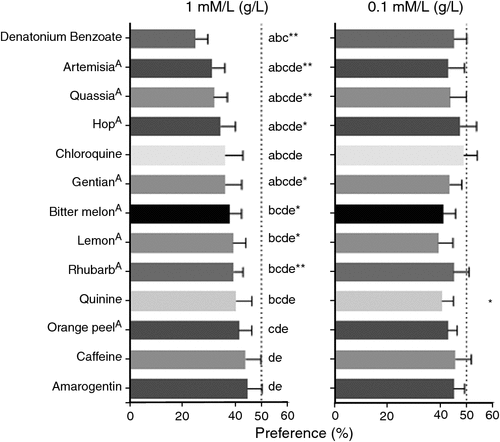A double-choice model to quantify negative preference to bitterness in pigs
J. Wang A , M. Fu A , M. Navarro A and E. Roura A BA The University of Queensland, Brisbane, QLD 4072.
B Corresponding author. Email: e.roura@uq.edu.au
Animal Production Science 57(12) 2422-2422 https://doi.org/10.1071/ANv57n12Ab081
Published: 20 November 2017
Bitter compounds have shown potential to decrease feed intake and fat deposition in pigs (Fu et al. 2015). However, identifying and quantifying bitterness in pigs is complex, since the standard double-choice (DC) models are based on motivation to consume. It works well when measuring positive preferences, but does not reliably identify negative preferences. This project aimed at developing a new DC model to measure negative preferences in pigs. Our hypothesis was that bitterness would counteract the positive preference for sweetness. Post-weaning piglets (Large White, 6.5 to 7.5 kg, half male and half female) were given a 2 min choice between a sweet solution (50 mm sugar) or and the same sweet solution added with one of 13 compounds (five pure chemicals and eight plant extracts) known to be bitter to humans at two doses (1 mm or 0.1 mm). The piglets were grouped in same sex pairs with similar bodyweight and randomly assigned to 24 pens with unrestricted access to a standard commercial feed and water. The DC tests ran twice daily (Sessions 1 and 2) per pen for 14 days (three blocks of 4 days and two additional days used to repeat missed results). This resulted in 18 replicates per treatment following an incomplete randomised block design where every treatment had six replicates per block (three in Session 1 and three in Session 2). Spare pens in every session were used to test a control treatment (sugar v. sugar). The amounts of each solution consumed were recorded and used to calculate preference rates. Data were analysed by using Duncan’s statistical analysis with ANOVA (SPSS v22.0, IBM, Armonk, NY, USA) in the General Linear Model.
The preference results are shown in Fig. 1. At the high dose, the addition of all compounds tested resulted in significant (P < 0.05 or P < 0.01) rejection except for orange peel, quinine, caffeine and amarogentin. In contrast, only quinine was significantly rejected in the lower dose. The results relevant to the extracts need to be interpreted with caution since non-bitter sensory factors may apply. We concluded that our model was successful in identifying negative preferences for bitter compounds and may become the foundation of future research on the functionality of bitter tastants in pigs.

|
References
Fu M, Collins C, Henman D, Roura E (2015) Chemical Senses 40, 363Supported by Australia Pork Limited and The University of Queensland.


